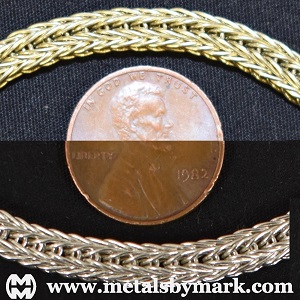
Matching 2S-2L bracelets
18k gold and 0.999 silver
Categories: Instruction and information; Jewelry
Word count/read time: 539 words; 2-1/2 minutes
Here is my webpage for
loop-in-loop
products.
HISTORY - Also called Roman Chain, Etruscan,
Foxtail, and more, many cultures have made them since the
inception of civilization. Predating chainmaille and Viking Knits,
they are pretty much the oldest jewelry chains.
The intricate construction makes it hard to believe they're handmade.
CLASSIFICATION - Sides refer to how many
directions the links orient themselves. Loops refer to how
many previous links each new link passes through.
It births one-sided single loop (1S-1L) and four-sided quintuple loop (4S-5L).
More sides and loops make a HUGE cross-section that won't flex.
PROCESS - Saw-cut rings are welded/soldered closed, elongated, squeezed,
and bent. They are inserted into the chain, wrangled into place, pulled tight,
and trued.
Picks, spreaders, jigs, mandrels, magnifiers, a vulgar appreciation
for jumbo micromaille, and asinine aspect ratios are typical fare.
Manufacturing them is exponentially slower than chainmaille.
WEAVES - Exquisite. Distinctive. Elegant. Most can be woven multiple ways.
Chains can be fluid enough to flow like liquid
silk or rigid enough to be used as sculpture. A wide range of wire diameters and jump
ring sizes produces intriguing and fascinating patterns.
Viking Knit chain
are sometimes mistaken for them.
MATERIALS - Jewelry demands precious metals.
Fine silver is ductile, malleable,
the shiniest metal, and flame-fused in open air. Sterling silver is good, too. Gold makes a
stunning chain!
Round wire is the most common. Square wire will restrict some movement
though it has a more distinctive look.
PRECISION - Loop-in-loops are among the most difficult
chains. The links are bent and shaped repeatedly before weaving
so they have to be perfect clones during every step. Small errors compound quickly.
Consistency becomes a huge concern because one errant link can deform a portion.
The weaver's skill is nowhere more visible than in a raw loop-in-loop chain.
Everything has to be flawless always.
There is no "organic" weave whose meandering, crooked
nature is acclaimed as a desirable design element. Poor workmanship is not glorious.
Consistency has never been so important.
DRAWPLATE - It is where the magic and misery happen, crushing and elongating the links.
The drawplate will homogenize weaves somewhat, becoming smoother (and hopefully more
uniform) as the strands squeeze together.
Unfortunately, relying on a piece of equipment and a healthy dose of luck
is asking for trouble.
Loop-in-loops can be woven in any desired style or appearance.
Loose chains are 100% by choice, and not a good choice.
If it requires a drawplate to fix it
then Viking Knit chains are better since they're more tolerant of mistakes.
I spend considerable time ensuring my links are consistent and well-made.
They are woven meticulously and symmetrically.
I cringe thinking of a board with holes deciding the fate of my chain.
ENDCAPS & CLASPS - Traditional methods use a ferrule
soldered on or mechanically affixed. They can be bulky and obtrusive.
I prefer jump rings and creative weaving for a low-profile clasp area with minimal
"non-chain" lengths. The nakedness is divine. Small endcaps are
used as needed.
SUMMARY - These weaves are
worthy of any precious metal when done properly. Their only purpose is jewelry
yet they make a deceptively strong chain to boot.
They are the apex chain with a staggering variety.
Posted by M: November 14, 2020
Please email any thoughts or comments regarding this post.
Comment Section
NOTE: Your comments will be included in this section
as long as they aren't illegal. This section is censor-free so show me
your intelligence or ignorance and everything in between!
|
2025
In a Pickle
Weird Silver Items
Stop, and Think
What's a Mentor for?
Organic
Pass the Torch
Four Fs of Jewelry
Those Are Nice Dimples
Yes, I Have Some
Good Deals
Transportaion Issues
Spining in Circles
Top Purchases 2024
2024
2023
2022
2021
2020
2019
2018
2017
2016
2015
2014
|